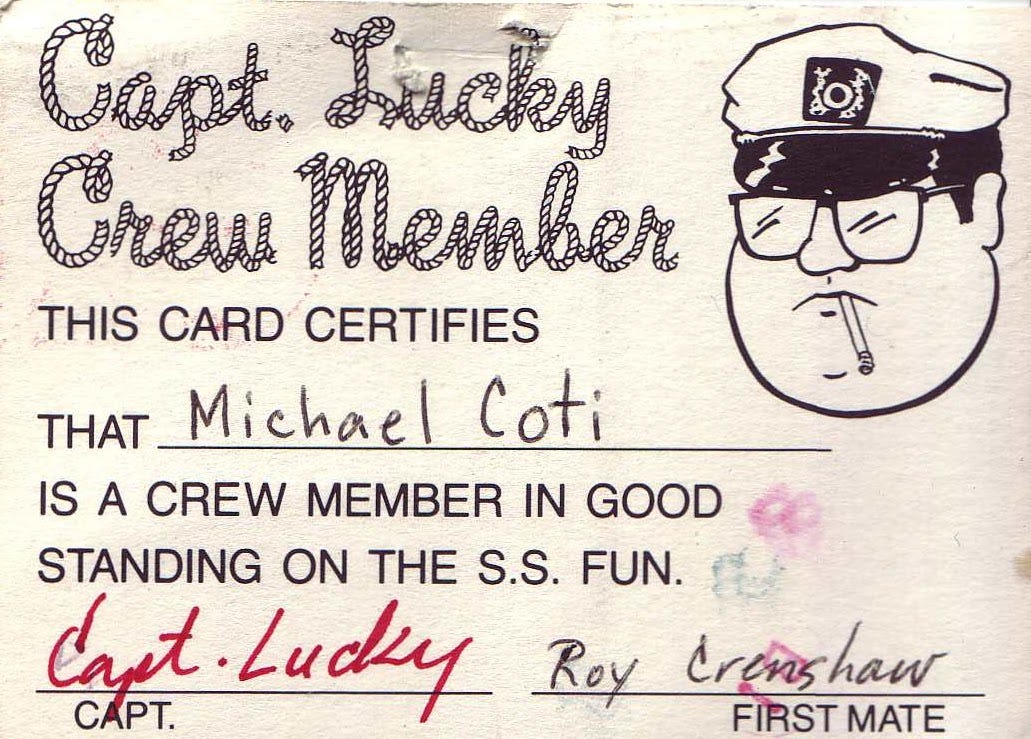Coté
"Make content about what you're curious about, not what you know."
Our new podcast is out, Software Defined Interviews, with me and Whitney Lee.
For the first episode, I interview Whitney. I’ve known her and worked with her now for, I don’t know, three years? She’s so great to talk with and so smart on all the cloud native stuff. In our episode, we go over her background, of course, but also plenty of “how you work” type stuff. For you nerds out there, we also talk about the evolution of the Kubernetes community and why security is always such a pain in the ass. Plus, at the end, you get the hear the discussion The Deep Dive crew would do.
Listen to it here, and if you want to hear more, subscribe to the podcast. I’ll also put the videos in the Software Defined Talk YouTube channel if you prefer that kind of thing. We’ve been circling around doing this for a year or so. We started with an idea for a show called “I didn’t read the book” (or something) where we’d interview authors about their books…which we hadn’t read. Maybe we’ll do that from time to time. Anyhow, then we just switched an interview show. There’s all sorts of people I’d like to interview, but never really do. It’ll be fun to see what Whitney asks them.
(Well, sure, it’s more like a re-boot of a defunct podcast, but just consider the episodes in the archive a fun find in the attic.)

Relative to your interests
How much would it cost to fork WordPress? I make a wild swag at doing it as a commercial venture.
Croissant - Good looking cross posting app for Mastodon, BlueSky, and Threads. Adding in Shortcut support would be awesome.
Shambles, But Make It Digital - School IT is a mess. As with enterprise IT, I bet it could be better by just choosing one platform, no matter the compromises. My kids have three or four systems (ManageBac, Google Classrooms, also email). They haven learned the corporate skills of keeping up with all of this, and it shows. If the school had a semester long course on “office work,” it might be OK, but they don’t.
As read by the AI
Tell me how you like this! Here’s some things I’ve “read” via perplexity.ai summaries, including the brief summary it made and a link to the longer summary:
Dana Gould’s keynote address at the Just For Laughs Festival offers insightful reflections on success, failure, and the nature of a comedy career. His personal anecdotes and experiences in the entertainment industry provide valuable lessons for aspiring comedians and performers.
The rise of AI workloads and increasing demands for data sovereignty and governance are driving a resurgence in private cloud adoption, with the market expected to grow from $92 billion in 2023 to $405 billion in 2033. This renaissance is fueled by the need for enterprises to leverage AI capabilities while maintaining control over their data and infrastructure. And, some use cases.
This presentation discusses Wix’s approach to addressing complexity in software development through a Platform as a Runtime (PaaR) model. Here are the key points and insights
Open source AI lacks a clear definition and faces significant challenges in implementation, with many so-called “open source” AI models failing to meet true open source standards. The concept of open source AI is complex and often misunderstood, with issues ranging from licensing and data privacy to the practical limitations of reproducing large language models.

Wastebook
“it was dimming my shine” jenn schiffer.
And: “new habits that are not workaholic-coded”
Rate my slop.
“Seeing people; talking about weird things; then trying to make sense of them in my head.” Lloyd returns to London, for the day.
“territorial unicorn” The Deep Dive crew.
Conferences
Talks I’m giving, places I’ll be, and other plans.
Cloud Foundry Day EU, Karlsruhe, Oct 9th. VMware Explore Barcelona, speaking, Nov 4th to 7th. GoTech World, speaking, Bucharest, Nov 12th and 13th. SREday Amsterdam, speaking, Nov 21st, 2024.
Discounts! SREDay Amsterdam: 20% off with the code SRE20DAY. Cloud Foundry Day 20% off with the code CFEU24VMW20.
Logoff
Back in the 90s, I’d spend hours watching The Comedy Channel. When I caught The Kids in the Hall, it was a special treat. Seeing those videos now is like comfort food on a rainy, cold day. And The Higgins Boys and Gruber - I was in the fan club! (Old guy remises!)
Croissant - Good looking cross posting app for Mastodon, BlueSky, and Threads. Adding in Shortcut support would be awesome.
Shambles, But Make It Digital - School IT is a mess. As with enterprise IT, I bet it could be better by just choosing one platform, no matter the compromises. My kids have three or four systems (ManageBac, Google Classrooms, also email). They haven learned the corporate skills of keeping up with all of this, and it shows. If the school had a semester long course on “office work,” it might be OK, but they don’t.
The flavor is a little...spare
I’d heard that the NotebookLM feature that creates podcasts was cool, but it’s wild! I’ve used it several times now. Here, you can listen to its summary of my chip tasting shorts. These are 60 second videos where my daughters and I try different chips - like foie gras, holiday stuffing, or just BBQ. You just give it some stuff and it comes up with a male host and female host doing a two people talking podcast. Somehow it figures out what to talk about and adds commentary to it.
By default, it comes out as slightly cliché, sometimes getting to levels of like Christopher Guest movie but without the jokes. But, other times it’s pretty amazing. Sure, it’s “slop,” but to gets close to human-made slop. The summarizing it does it good too.
I’ve done many more, including one five years of our State of Kubernetes survey (pretty all over the map) and Jeffrey Dahmer (my wife listens to a lot of true crime podcasts, so I wanted to get her take on the output).
Using a tip from “Optimal-Fix1216,” I figured out how to put “producer notes” into the podcasts. These are simulated notes that a producer has given the hosts. It allows for some guiding of the content: putting in pauses for ad breaks, being a little more sarcastic and telling jokes, and maybe making the episodes longer, like 20 minutes instead of 8. Here’s a generic one, and here’s one for doing a Software Defined Talk episode. You add these notes as sources in the NotebookLM notebook and - maybe? - it uses them to guide the two. Sometimes it obviously work: they’ll do an ad break. And maybe instructing them to go longer works too. Here’s a 32 minute one going over my book of my The Register columns, Digital WTF.
I’m trying to get them to do a scat musical intro/jingle thing, but no luck yet. However, they’ve started burping in some episodes…?
What could you use NotebookLM Audio Overview for?
It’s fun to make and listen to these. Here’s some theory on uses:
Summaries, quick learning. One of the first uses I remember hearing about is making a personal podcast. For example, get those ponderous academic PDFs and have it make a discussion of each.
Modeling analysis and thinking. Related, I’m thinking it might be good supplemental tutoring for my kid’s school. My son is starting to get into “write an essay about this book” classes. Maybe these two could have some discussions about the books. Sure, this could be cheating if he just converted what they said into an essay, but more of what I’m interested in is modeling how to think about that kind of literature analysis. Also, my kids might be more aural learners than readers - or they could be both! Multi-channel learning.
Story pitches and outlines. Another type of modeling could be writing corporate copy, blog posts, podcasts. For example, you could take the keynotes from a big conference, throw in blog posts, even put in analyst and blogger commentary. I did this for our big conference, Explore. The Audio Overview did a good job of picking out themes and coming up with with something to say about them. Sure, it was basing that on the content I fed it. But, have you ever sat in front a pile of content and tried to figure out what to write about it? The generated episodes are a good start. And, you could just convert them back to single author prose - I haven’t tried that yet.
Instant reactions. Let’s say you’re at a big tech conference and just watched their keynote. If you had a recording of it, you could give it to Audio Overview, wait ten or 15 minutes, and have an instant, on the floor take. If you pre-loaded the notebook with a bunch of context and background material, it might make it better. Based on the experiments I’ve been doing, these would be really helpful. Would you publish them? I mean…yeah?
Simulating press, analyst, and influencer interviews. When you’re doing a big announcement, you do a lot of press/analyst/influencer interviews. What are they going to ask? What would you answers be? What are those people going to say on their weekly podcast or round-table video wrap-up? You can get the start of an idea from the Audio Overview. Of course it’s not going to be perfect or reliably predictive. That’s not the point: it’s to get started.
Brainstorming. Because it’s a podcast, the two hosts are sort of figuring out what they think on the fly. That’s the way a lot of podcasts are - especially the ones I do! In that way, if you gave them some rough ideas, you could simulate a brainstorming session: getting some people in a room, starting with basic concepts, and working through what to think of them. An important aspect here would be that you can re-generate the episodes over and over. So, you could have three, five, etc. brain-storming sessions. Here, you could chain things together soon. Have it generate five sessions, convert them back to text, and then have another AI session pick the best and worst (and neglected) ideas from those sessions.
Anyhow! I recall seeing people automate some of this with the APIs for Gemini. I of course just use the web interface. There’s some whacky world where you have an AI pick out interesting news stories in the morning for you and then generate one of these episodes, puts it in your podcast feed, and then you can listen to it in the morning.
Wastebook
“Surprisingly interesting podcast from a text file of pure blank spaces”
“But it’s not about catching criminals. It’s about catching vibes.” Bop Spotter
“(I think I keep Instagram more intimate than the average person. My gauge for if I follow someone is ‘If I saw them at the grocery store, would I stop and talk to them for awhile?’)” Riley Walz
“Often programmers use “die” to mean “decline in relative marketshare”, not absolute marketshare.” Here.
“The candidate or the couch.”
In enterprise vendor marketing, it’s easy to fall into the trap of only talking about the benefit and outcomes of a product. Often, you also need to sell the idea of the product itself, and even the educate people on how to use it. Kubernetes wouldn’t have been successful if that community only talked about the benefits; you had to see all the demos for years of how it worked, and also be convinced that this is how infrastructure should be managed and how applications should be packaged, architected, and configured to run on Kubernetes.
“Whatever it is you want to do, somebody has already figured it out for you.” Here.
“The ribeye served with a smile over clean linen is fine, but it’s got nothing on tacos unceremoniously dropped on a plastic table you can afford to share with someone you love.” Here.
“their big ‘this is what we are doing’ conference…” // Great phrase for vendor conferences.
Relative to your interests
RTO or GFTO - RTO is like a dress code.
Survey Says: Tech Spending Is Up, But AI Rollouts Slower Than Expected - Initial AI hype is finally going back to reality. // " The AI wave is still building, but the future has been slower than anticipated. Today only 5.5% of identified AI use cases are in production, a sobering reality check on respondents' Q1’24 projection that 52% of identified use cases would be in production over the next 24 months."
CEO Kurian: ‘When I Started, Most People Told Me We Didn’t Have a Chance’ - “We’re now the fourth largest enterprise software company.”
The Top 1 Percent Paid a Lot of Taxes in 2021 - ”In 2021 the top 1 percent of taxpayers in the United States paid 36 percent of all federal taxes (they have 21.1 percent of income). This figure had been below 20 percent until the mid-1990s, and as recently as 2019 it was just 24.7 percent (they had 15.9 percent of the income that year).”
gabrielchua/open-notebooklm - Prompt for generating a podcast: “You are a world-class podcast producer tasked with transforming the provided input text into an engaging and informative podcast script. The input may be unstructured or messy, sourced from PDFs or web pages. Your goal is to extract the most interesting and insightful content for a compelling podcast discussion.”
The top five AI lessons learned from IBM’s presence at SaaStr 2024 - ”Build solutions that solve a specific enterprise pain point” // as we said in the PaaS days: “find the app.”
Enterprises funnel IT spend into AI and data, Accenture says - ‘Enterprises are shifting IT spending to investments that support data modernization and AI technologies rather than increasing overall budgets. - “What we are seeing is that as they’re saving money, they want to invest it in things like AI and data,” Sweet said Thursday. “That’s really the dynamic that’s going on: save to invest.”’
Platforms Engineering - Not a fan: “Platform engineering isn’t gluing a bunch of off-the-shelf tools together. More templates, variables, and YAML isn’t going to make it easier for application developers to deploy faster, reduce cognitive load, and still innovate (a topic for another time). And the CFO isn’t going to fund multiple platform teams–at least not part of the same organization.”
McDonald’s touchscreen kiosks were feared as job killers. Instead, something surprising happened - If you can come up with other ways staff can spend time, automation could be good for workers and customers. For example, come up with more complex products that require more human touch, speeding up delivery, or just busing tables. But, yeah, if you’re not going to change your business, then automation probably means firing people.
Why So Few Matt Levines? - There’s not enough news with the same types of events that happen over and over with clear, public records.
Some advice and good practices when integrating an LLM in your application - Yup!
Logoff
I mentioned re-starting the Software Defined Interviews podcast. We just recorded our first episode yesterday, and it’ll be out tomorrow. Make sure you subscribe to it to start listening. I’ll of course put a link in here next episode.
Deep Dive: Digital WTF book discussion
The Deep Dive crew discuss my book, Digital WTF. This is a collection of columns I wrote for The Register between 2014 to 2018. This one is 32 minutes, which gives a lot of time to see the weird things - strange noises they make, repeated phrases and talking patterns. In the producer notes, I asked them to do a scat intro, but they didn’t manage it. Maybe next time!
RTO or GFTO - RTO is like a dress code.
Deep Dive - Five Years of State of Kubernetes Surveys
I ask the NotebookML Deep Dive crew to comment on the past five years of our State of Kubernetes Surveys. Check out one of blog posts on our most recent survey.
Deep Dive: Jeffrey Dahmer - AI Generated
I asked the NotebookML Deep Dive crew to discuss Jeffrey Dahmer. I just gave it the text of the wikipedia page on him. My wife listens to a lot of true crime podcasts, so I wanted to see what she thought of the Deep Dive crew. She said it was good!
CEO Kurian: ‘When I Started, Most People Told Me We Didn’t Have a Chance’ - “We’re now the fourth largest enterprise software company.”

